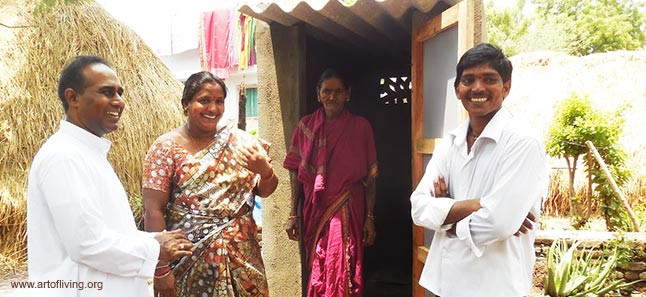A software engineer constructing toilets in the villages of Andhra Pradesh is a rare sight. This is precisely what you will find Sudhakar Veeravalli doing. Armed with a Master's Degree in Computer Engineering from the University of Texas, Sudhakar quit his job in the USA at the age of 38. For the last four years, Sudhakar has been working to understand the needs of rural India. He aims to engineer solutions to address the issue of open defecation, improve hygiene and sanitation and better health for rural residents.
As the Director of the Back to the Roots (BTTR) Project, Sudhakar drove the construction of toilets across villages in Andhra Pradesh. The Back to the Roots (BTTR) Project of The Art of Living has facilitated the construction of 216 toilets in Andhra Pradesh - boosting the fight against open defecation. The vision is to create open defecation free (odf) villages.
However, he is not alone. Other youth leaders like Kala Alagappan and their team facilitated the construction of toilets and drew attention to a severe hygiene and sanitation issue.
Mission clean India
Kala Alagappan from Karnataka has been training youth leaders in rural India to realize the clean India mission.
Flushing out the unsanitary practice of open defecation, Kala has played an instrumental role in making the villagers take a step towards better hygiene and sanitation practices.
A veteran in developmental work at the grassroots, Kala noticed that all the houses in Totlavallur were huts, with no provision for toilets. She started a nagara sankeertana (the practices of walking and singing bhajans that is common in villages) and visited every part of the village. Soon the children and women joined her during the sankeertana.
Kala began visiting each home to talk to the residents. She would speak on the necessity of practices for better health, hygiene, and sanitation. During her interactions, she found that most women were facing health issues because they avoided stepping out of their homes till sunset. They avoided drinking much water. Women also felt unsafe venturing out after dark.
4' x 3' steps towards better health
While the need for change was apparent, willingness and participation of the beneficiaries were vital to the success of the mission. . To help people get over their stress and come together in camaraderie, Kala conducted Nav Chetana Shibirs’ (The Art of Living Rural Programs) for the villagers.
Many government officials also expressed their interest to learn these techniques. Their interest led to a series of Art of Living Happiness Programs where numerous officers from the agricultural, engineering and rural development departments learned meditation and the Sudarshan Kriya. Not only was good health a result of these programs, but it also ushered in a renewed sense of community welfare. This marked the birth of the 4’ x 3’ dreams — the 20 toilets. A small step towards an odf village.
Celebrating the importance of sanitation
Kala planned and surveyed to select the beneficiaries by their economic strength, ownership of the land on which the toilets were to be built, the number of women and girls in the family among other factors. Preference was also given to people with disabilities. A mason was hired for the construction.A plan for the toilets was drawn up by government standards; sized 4’ x 3’ (four feet by three feet) with galvanized iron (GI) sheet roofs.
Hurdles kept arising in the form of land and labor issues, finance, conventional thinking, and loss of time. But that only brought more determination in the team to complete the project, work towards odf villages and contribute to the clean India mission.
July 23, 2014, marked a special day for the residents of Totlavalluru. Amid a festive atmosphere, 20 toilets were inaugurated.
The families that owned the brand new toilets were taught how to keep them clean and were also provided with all the necessary materials. Inspection of these toilets has been planned to encourage proper maintenance.
More access to hygiene & sanitation
The government has the scheme to cover the cost of building toilets, but the money is released only after construction. This had become a hurdle as nobody in the village had the financial means to provide initial investment.
The success of the 20 toilets initiative has encouraged the field officers to get funds sanctioned from the government for toilets for the entire administrative division. On assessment, the total number of toilets is estimated at around 500.
Today, there is great eagerness and demand from the villagers to have permanent toilets built in their homes, giving impetus to the dream of an odf village. Kala and her team are also exploring various ideas to aid the few families that live in temporary tents in villages.
The Art of Living volunteers funded the construction of 100 toilets. The Art of Living received government support for the construction of additional 116 toilets.
Source: The Art of Living Bureau of Communication
Story updated: 2017




